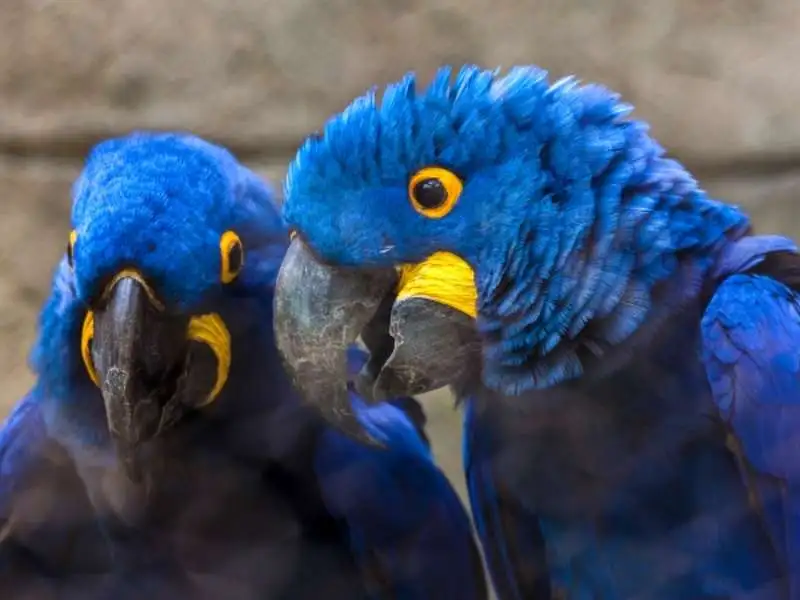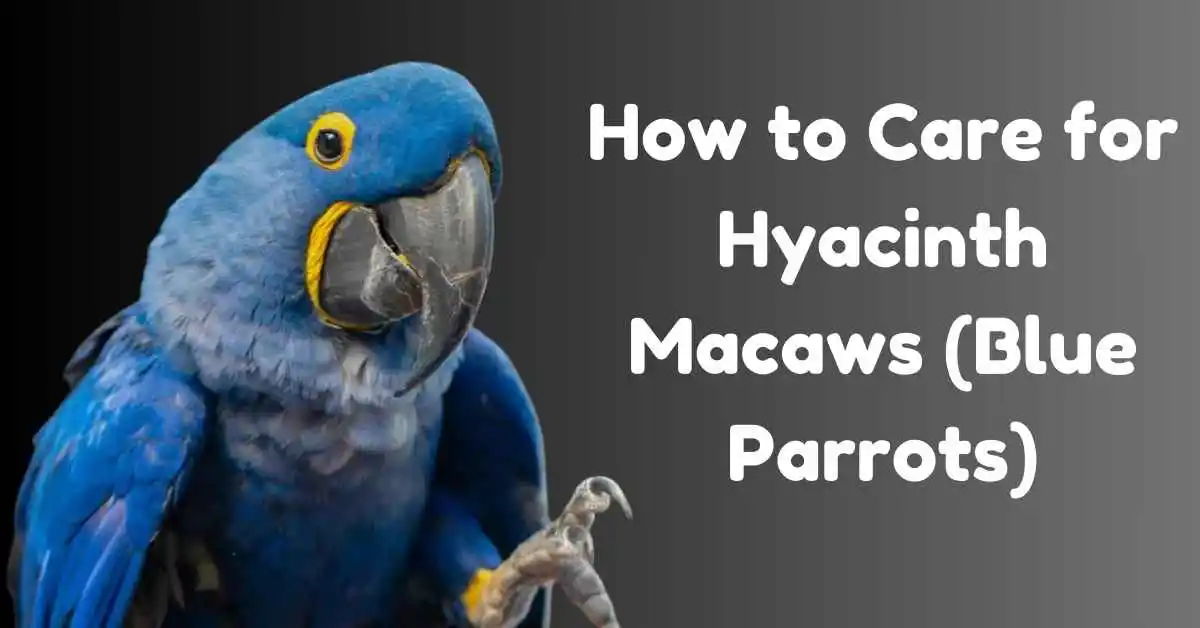How to Care for Hyacinth Macaws (Blue Parrots)
- Provide a spacious cage: Hyacinth Macaws are large birds, and they need a cage to roam freely, which is essential for them.
- Safe environment: The cage should be kept in a very safe place so that no damage of any kind can occur.
- Proper diet: A variety of fruits, vegetables, and nuts should be fed, and chocolate and other foods should be avoided because they are toxic.
- Freshwater: Always offer them the best clean and fresh water.
- Vet care: You should make sure that they are up-to-date, so you should use the vaccinations for them and you should also consult a doctor for them.

Origin and History:
The hyacinth macaw (Anodorhynchus hyacinthinus), also known as the “blue parrot”, is a South American bird found mainly in Brazil, Paraguay, and Bolivia. It lives in the Pantanal, Cerrado forests, and Amazon regions.
Hyacinth Macaws were described by European explorers in the 18th century and became famous for their blue wings and yellow markings, which made them part of the pet bird trade. Due to conservation measures, such as breeding programs and habitat protection, their numbers are slowly increasing.
Temperament and behavior:
Hyacinth macaws are kind, loving, and playful birds. Hyacinth Macaws enjoy being with their owners and need attention. Even though they are large, they are calm and not aggressive. They live in pairs or small groups in the wild and communicate through sounds. They are smart, learn quickly, and need strong toys to chew. With proper care, they can be great pets.
Speech and Vocalizations:
These birds are loud and make excellent sounds. Hyacinth Macaws are very different from other birds. They make various sounds, whether in the forest or a forest. It is a loud sound that has to be made, it goes up to two. These birds are very popular with those who like noise and want attention for their sound and joy.
Colors and Markings:
Hyacinth macaws are known for their beautiful blue feathers. Hyacinth Macaws have yellow circles around their eyes and a yellow mark near their beak, which looks beautiful with the blue color. They have long tails and are good fliers. Males and females look the same, and the blue color of the younger macaws becomes brighter with age.
Housing:
This large bird needs a large living area. A regular cage is not suitable, as most cages are small and Hyacinth Macaws can easily escape from them.
Choosing the Right Cage:
Choose a large, sturdy stainless steel cage for your blue parrots, as Hyacinth Macaws can break regular cages with their beaks. It is best to have a special cage or room for them so they can have a place to fly and play comfortably. Provide sturdy windows and chew toys due to their destructive habits.

Cage Setup and Accessories:
Hyacinth macaws are similar to small parrots and small macaws as Molkin cockatoos are to cockatiels. They are brilliant birds and require many toys each week.
Cleaning and Maintenance:
Wash your blue parrot’s cage daily, remove food, dirt, and waste, and refresh the water. polished once a week and do a deep cleaning once a month. Provide new toys and fresh food daily. Get regular veterinary checkups and pay attention to changes in health.
Temperature and Humidity Requirements:
Blue parrots do best in a warm, close environment. Hyacinth Macaws prefer temperatures between 65°F and 85°F and should be kept away from extremes of cold or heat. Humidity should be between fifty and seventy percent as dry air can cause respiratory and skin problems. Monitor the heat and heaviness to keep them at the right level.
Compatibility:
Blue parrots are social birds and can form good relationships with other larger parrots if introduced slowly and properly. Hyacinth Macaws need their own space to avoid fights. Hyacinth Macaws are happy with pairs or companions but are wary of strangers. Do not keep with smaller birds as their size can be harmful. Hyacinth Macaws form strong bonds with their human caretakers, so time is essential.
Common Health Problems:
Blue parrots can suffer from problems such as respiratory diseases, feather breakage, nutritional deficiencies, obesity, egg-laying, and “Pacetine Back and Feeder Disease.” Regular vet checkups, a balanced diet, and a clean environment are essential to prevent these.
Diet and Nutrition:
A balanced food is essential to keeping blue parrots healthy, including high-quality pellets, fresh fruits, vegetables, and nuts. Feed seeds sparingly as they are high in fat. Avoid chocolate, caffeine, alcohol, or avocado. Cuttlebone or mineral blocks are important for calcium. Always provide fresh water and keep the diet balanced.
List of Hyacinth Macaw Care Supplies and Costs:
| Cage | $1,000–$3,000 |
| Shipping Costs | $50–$90 |
| Vet Exam/Shots | $50–$200 |
| Travel Cage | $200 |
| Toys | $45–$55 |
| Perches | $15–$65/each |
| Cage Light | $85–$135 |
| Nail/Wing Clipper (optional) | $8 |
| Cage Liners | $20 |
| Cage Cleaner | $8 |
| Flight Harness | $35 |
| Food and Water Bowls | $10 |
LifeSpan:
Blue parrots can occupy 50 to 60 years in captivity, and some have lived to be 70 or more. Their age depends on their diet. They should be given the right and best food and should be exercised in the best way. Their numbers are decreasing due to various natural threats to the forest. They also need the best places where they can survive for such a long time.
Conclusion:
In Conclusion, blue parrots are intelligent, friendly, and special birds that require care. Their blue feathers make them beautiful, but they need a large space, a sturdy cage, and toys. Feed them fruits, vegetables, and nuts, and keep them clean. Hyacinth Macaws love their owners, but their loud voices and long lifespans make them better suited to hardworking people. They need to be protected and cared for because their numbers in the wild are dwindling.







